China’s property market soars to new highs
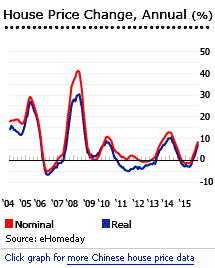 China's property boom is back with a vengeance! After many government measures to support the housing market, there has been a dramatic rise in transactions and prices. High-profile cities like Shenzhen, Guangzhou and Shanghai have led with significant price-rises.
China's property boom is back with a vengeance! After many government measures to support the housing market, there has been a dramatic rise in transactions and prices. High-profile cities like Shenzhen, Guangzhou and Shanghai have led with significant price-rises.
In Shanghai, the price index of second-hand houses rose by 8.31% (6.9% inflation-adjusted) during the year to October 2015, in contrast to a y-o-y decline of 0.17% (-1.84% inflation-adjusted) the previous year, based on figures from Ehomeday.
This was supported by recent data released by Colliers International, which showed that the average sales price of new houses in Shanghai rose by 18.6% to CNY31,844 (US$4,930) per square meter (sq. m.) in Q3 2015 from a year earlier, but unchanged from the previous quarter, buoyed by strong demand for high-end or luxury properties. The area between the inner ring road and the middle ring road saw the biggest increase in house prices.
In Q3 2015:
- Villa sale prices were up by 13.8% y-o-y to CNY34,874 (US$5,399) per sq. m., but were down by 3.9% q-o-q
- Apartment sale prices rose by 19.4% y-o-y to CNY31,424 (US$4,865) per sq. m., but were unchanged from the previous quarter
In Shanghai’s high-end market, the average residential property sale price stood at CNY59,534 (US$9,216) per sq. m. in Q3 2015, up by 8.1% from a year earlier, according to Colliers International. The average sale price of low- to mid-end properties rose by 10.2% y-o-y to CNY22,569 (US$3,494) per sq. m.
In Beijing, existing home prices rose by 4.9% in November 2015 from the same period last year, to an average of CNY43,349 (US$6,711) per sq. m., according to Century21 China Real Estate.
In Guangzhou’s ten urban districts, the average sale price of new houses rose by 10.5% y-o-y to CNY18,082 (US$2,799) per sq. m. in Q3 2015, according to the Guangzhou Municipal Land Resources and Housing Administrative Bureau. On a quarterly basis, Guangzhou house prices rose by 10.8% in Q3 2015.
In Shenzhen, the average sales price of new houses rose by 23% q-o-q to CNY35,628 (US$5,515) per sq. m. in Q3 2015, according to Colliers International. The sales price of four-bedroom units and duplex apartments recorded the biggest quarterly increase of 40.8% and 41.9%, to CNY47,306 (US$7,323) per sq. m. and CNY43,186 (US$6,685) per sq. m., respectively.
Too much government intervention?
Property prices in China rose rapidly from 2000 to 2008, fuelled by low interest rates and cheap credit. There was a 121% rise in the price index for second-hand homes in Shanghai (85% inflation-adjusted) from Q1 2003 to Q2 2008, according to Ehomeday. However during the global crisis, China's housing market slowed sharply from end-2008 to mid-2009.
Arguably, one of the Chinese housing market's central problems has been excessive government intervention, greatly exaggerating the housing cycle.
Repeatedly, the government has stepped in to avoid over-heating - then stepped in again, to avoid the resulting slump. So China's housing market see-saws between one extreme and the other, within the general context of an over-valued and over-stocked housing market.
Recent property cycles illustrate this.
In November 2008 the government introduced a CNY4 trillion (US$585 billion) post-financial crisis stimulus package.
Developers were now easily able obtain loans, with lower capital requirements.
Buyers too took advantage, with looser lending conditions and lower interest rates. The package reduced the property deed tax rate for first-time buyers of small apartments to 1% from 1.5% (January 2009 to December 2009), introduced stamp duty and land value-added tax exemptions, and exempted sellers of residential property from the 5.5% business tax, if the properties were sold after more than two years.
The result? Existing house prices surged by 19.82% in Beijing during 2013 (16.93% inflation-adjusted), and rose by 12.85% in Shanghai (10.13% inflation-adjusted).
Too much! The boom of led to uninhabited so-called ghost towns. The ratio of residential floor space under construction to floor space sold also rose sharply. In 2008, for every one sq. m. of space sold, 3.9 sq. m. was under construction. The ratio rose to a record high of around 4.4 sq. m. in 2012, according to China economist Patrick Chovanec.
In March 2013 the State Council introduced measures to reassert control:
- Major cities are now required to publish, every year, an annual housing price control target.
- Cities with overheating housing markets are required to increase their supply of commodity housing, and their land supply. Conversely, cities with declining prices are required to keep prices stable by stimulating housing demand.
- Where dwelling price rises exceed city price control targets, People’s Bank of China (PBOC) branches will increase down-payment requirements.
- Tighter mortgage restrictions on second home purchases were introduced, and buyers without a local registration barred from buying more than one property.
- Banks must not give loans to developers that hoard land, or participate in price-inflating activities.
- Local governments must boost low-income housing production.
- The government will continue to reform property taxes. The trial holding tax, first introduced in Shanghai and Chongqing, is to be implemented in other cities. Also to be implemented is a transaction tax.
One method of reducing upward pressure in the housing market is to increase social housing provision. So in October 2013 Beijing introduced a new scheme to house middle-income earners. These new dwellings would cost more than public housing, but 30% less than normal residential dwellings.
In November 2013, Shanghai's municipal government tightened by increasing minimum down payments for second home purchases from 60% to 70%. Non-Shanghai residents also faced tighter qualifications to purchase homes in Shanghai.
Some local governments implemented even stricter lending conditions, while banks slowed or even stopped mortgage lending.
Due to these tightening measures, the housing market slowed sharply. After robust price rises of 12.85% in 2013, during 2014 house prices dropped in Beijing and Shanghai by 4.16% (-5.67% inflation-adjusted) and 1.33% (-2.89% inflation-adjusted), respectively.
Now, after this downturn, we're into yet another reversal. Over the past year the government has eased property curbs, and on September 30, 2014 the central bank loosened mortgage restrictions, giving homeowners with paid-off mortgages wanting a second property the same terms as first-time buyers, including a down payment minimum of 30% (previous minimum: 60%). The central bank cut its benchmark one-year lending rate by 25 basis points to 4.35% in October 2015, the sixth rate cut since November 2014. Mortgage interest rates for first-home purchases fell to a new record low of 4.66% in November 2015. The government also recently announced a plan to purchase unsold residential properties, and convert them into low-cost housing, in order to reduce inventory levels.
In the first nine months of 2015, the value and the area of new residential property sales in China rose by 18.2% and 8.2%, respectively, from a year earlier, according to the National Bureau of Statistics of China.
This isn't a blip - the housing market will continue strong
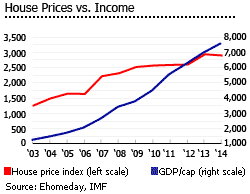
The Chinese economy is undoubtedly slowing: growth is projected to be 6.8% this year, down from 7.3% in 2014, 7.7% in 2013, 7.7% in 2012 and 9.5% in 2011, according to the International Monetary Fund (IMF).
Yet China’s property market, especially Shanghai, will likely remain robust, medium-term. That's because the government seems almost certain to continue its expansionary policies. The housing market is deeply intertwined with China's rebalancing from export-led growth to domestic-led growth.
"To maintain GDP growth at 6.5 per cent next year, the Chinese government will continue to take supportive measures for the real estate sector," said Standard & Poor's credit analyst Dennis Lee. adding that property transactions and prices are expected to increase by 5% next year.
“This is a pretty sustainable recovery into 2016,” said Wee Liat Lee of BNP Paribas. “As you move into 2016, the demand supply dynamics will move in favour of demand being better and supply being gradually weeded out. So, actually I predict that more cities will have price increases next year,” Lee added.
Reducing the housing glut
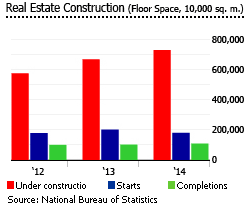
There is now a lull in high-end completions, because of the focus of government and developers during the previous two years on reducing luxury housing inventory.
In Beijing, there were no new completions in the luxury apartment market in Q3 2015, according to Colliers International. In the villa segment, the total stock increased by just 2.1% q-o-q to 14,731 units over the same period. Redwood Valley II in the East CBD submarket added 300 units of new villas in Q3 2015. On the other hand, the total stock of serviced apartments dropped 5.2% q-o-q to 7,420 units in Q3 2015, mainly due to the conversion of some developments into office spaces.
In Shanghai, the new supply of new residential properties was about 24,568 units (3 million sq. m.) in Q3 2015, up by 2.6% from the previous quarter but down by 8.3% from a year earlier, according to Colliers International. In contrast, there were almost no new supply entered the market in Yangpu District in Q3 2015. The supply of villas fell by 7.5% y-o-y to 1,112 units (260,534 sq. m.) in Q3 2015. Likewise, the supply of apartments also dropped 7.3% y-o-y to 23,456 units (2.8 million sq. m.) over the same period.
Shanghai’s Pudong saw the biggest amount of new housing supply in Q3, at 4,002 units (514,801 sq. m.), followed by Nanhui with 3,413 units (371,186 sq. m.). In Qingpu District, new housing supply surged by 25.7% y-o-y to 2,836 units (362,267 sq. m.) over the same period.
Home sales soar, especially in the luxury market

In Beijing, transactions of existing homes picked up 57.4% to 19,468 units in November 2015 from the same period last year, according to Century21. Over the same period, secondary home sales in Shanghai also surged by 82.5 % y-o-y to 39,933 units. This was in sharp contrast with the declines in homes sales seen the previous year.
The same surge in demand was also reflected in the figures released by Colliers International.
- In Shanghai, home sales soared by 63% to 28,058 units (3.4 million sq, m.) in Q3 2015 from a year earlier. The high-end residential market saw a y-o-y increase in sales of 121% over the same period, to 5,330 units (864,843 sq. m.).
- In Beijing, the total sales of luxury apartments and villas surged by 93.5% and 89.7%, respectively, in Q3 2015.
“In the secondary market, demand is mainly from end-users, including first-time buyers and upgraders,” Century 21 said. “For them, it’s still good time to buy at the end of this year.”
Mortgage lending rises amidst low interest rates
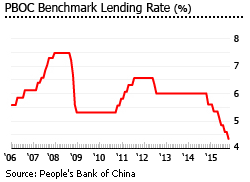
Mortgage lending is rising again, with interest rates low, and lending rules lenient.
In October 2015, the People’s Bank of China cut the key interest rate by 25 basis points to 4.35%, its sixth rate cut since November 2014. The government has also reduced the minimum downpayment for second-home buyers three times this year. In March 2015, property sellers were exempted from paying transaction tax if they had owned the property for at least two years.
In September 2015, the total amount of outstanding CNY-denominated property loans rose by 20.9% y-o-y to CNY20.24 trillion (US$3.13 trillion), according to the People’s Bank of China (PBOC).
Small mortgage market
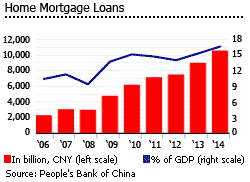
China’s mortgage market remains small, with home mortgage loans at around 16.7% of GDP in 2014, up from 10.43% in 2006.
Some factors hindering mortgage market growth:
- Mortgage lending is dominated by state-owned commercial banks.
- Banks prefer to offer loans for new housing. The mortgage market for old housing is undeveloped.
- A mismatch between property registration and mortgage policies.
- Banks lean on real estate developers when buyers default on loans.
The mortgage market is led by four major state-owned commercial banks namely: Bank of China, China Agriculture Bank, China Construction Bank and Industrial and Commercial Bank of China.
Rental prices stabilizing, yields remain very low

Gross rental yields in China are very low. In early-2015, gross rental yields on almost all sizes of apartments in Beijing are below 2.5%, and in Shanghai below 3.2%, according to Global Property Guide research. Yields below 3% are a danger signal.
Chengdu is an exception. Yields appear healthy here, according to Global Property Guide research. We are not sure if this is some kind of statistical fluke, and our result certainly seems somewhat odd because yields on large apartments are above those on smaller apartments. Chengdu looks a little like Beijing and Shanghai used to look like, in terms of return on investment.
The rental market in China is heavily regulated, and the system favours the landlord. The landlord may get large payments for breaches of contract committed by the tenant. Although major cities have no rent controls, other smaller cities may have.
In Beijing, the average rent of luxury apartments increased by just 0.9% in Q3 2015 from the previous quarter, to CNY134.8 (US$20.87) per sq. m. per month, according to Colliers International. Likewise, villa rents in the capital city were also up by a meagre 0.6% q-o-q to CNY84.7 (US$13.11) per sq. m. per month in Q3 2015. In the serviced apartment market, the average rent dropped 0.9% q-o-q to CNY221.9 (US$34.35) per sq. m. per month over the same period.
In Guangzhou, the average rent of serviced apartments dropped 1.9% q-o-q to CNY206.5 (US$31.97) per sq. m. per month in Q3 2015.
In Shenzhen, the average rent of serviced apartments also dropped 0.9% q-o-q to CNY246.1 (US$38.10) per sq. m. per month in Q3 2015.
China's economy decelerated in 2015
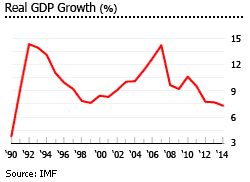
China's economic growth is projected to be 6.8% this year, its lowest growth in 24 years, according to the International Monetary Fund (IMF).
From an average growth rate of 12.7% annually from 2005 to 2007, China has experienced a slowdown in recent years, with an average annual real GDP growth rate of 9.6% from 2008 to 2011. The country’s manufacturing sector grew only 5.7% during the year to September 2015. Likewise, fixed-asset investment growth slowed to 10.3% y-o-y during the first nine months of 2015.
In November 2013 China unveiled a 60-point reform plan to pave the way for China’s transition to consumption-driven growth. The plan includes boosting China’s urban population by easing the one-child policy.
This is not an easy transition for China.
Between June and August 2015, China’s stock market went into a meltdown, wiping out hundreds of billions of dollars in market capitalization. Triggering the crash was a relaxing of margin trades and concern over lofty valuations.
In August 11, 2015, PBOC devalued the yuan by 1.87% against the U.S. dollar, in a bid to boost the competitiveness of Chinese exports. The following day, the central bank devalued the yuan by another 1.62% against the U.S. dollar.
The risk of deflation is also growing. China’s annual consumer inflation stood at 1.5% in November 2015, according to the National Bureau of Statistics of China. Nationwide inflation was 2% in 2014, down from 2.6% in 2012 and 2013, and 5.4% in 2011
Yet urban unemployment remains low, at only 4.05% in September 2015. During the first nine months of 2015, China was able to create about 10.66 million new jobs for urban residents, according to the Ministry of Human Resources and Social Security.